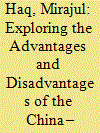|
|
|
Sort Order |
|
|
|
Items / Page
|
|
|
|
|
|
|
| Srl | Item |
| 1 |
ID:
180635


|
|
|
|
|
| Summary/Abstract |
We construct a connected network between China and the economies that are financially linked to it, based on the network topology of variance decompositions, and measure the cross-border contagion of financial risks among these economies. We then examine whether the concerted use of macroprudential policies mitigates the cross-border contagion of financial risks. The empirical results show that the tightening of macroprudential policies, especially counter-cyclical capital buffers and limits on credit growth, in economies with net spillover risk (e.g. the US and China), can reduce the cross-border spillover of domestic financial risks to other economies. The concerted use of macroprudential policies can contribute to global financial stability. However, the tightening of “capital” macroprudential policy tools will increase domestic cross-border absorption of financial risks. Hence, macroprudential regulation of cross-border capital flows must be strengthened.
|
|
|
|
|
|
|
|
|
|
|
|
|
|
|
|
| 2 |
ID:
180634


|
|
|
|
|
| Summary/Abstract |
The impact that the Belt and Road Initiative (BRI) has had on carbon emissions is a hotly debated issue. Using a panel dataset of 178 countries from 2002 to 2017, and applying the quantile difference-in-difference method in different industries, this study finds that, first, the BRI overall tends to reduce the carbon emission intensity of BRI countries. Second, the impact of BRI on reducing the carbon emission intensity is significant for BRI countries at higher (0.8 and 0.9) and lower (0.2 and 0.3) carbon emission intensity quantiles but it is insignificant for those at medium levels. Third, the BRI has significant impacts on reducing carbon emission intensity in the energy-intensive industries, and this effect is the highest at the quantile level of 0.9 for all three industries considered here: transportation, electric and heating, and manufacturing and construction. These results indicate that establishing BRI cooperation with China will improve the environment and enhance the sustainable development ability of BRI countries.
|
|
|
|
|
|
|
|
|
|
|
|
|
|
|
|
| 3 |
ID:
180637


|
|
|
|
|
| Summary/Abstract |
This paper explores whether the China–Pakistan Free Trade Agreement (FTA), which entered into effect in 2007, has led to advantages or disadvantages for the participating countries. It assesses the gains and losses associated with the agreement rigorously using two different approaches. First, the revealed comparative advantage index is calculated for 10 commodity groups. This identifies the commodity groups in which the participating countries have a comparative advantage. Second, trade creation and trade diversion are estimated for overall imports and for the commodity-group level imports. This analysis provides useful information about the commodity groups in which a particular party to the FTA is experiencing an advantage or a disadvantage. The findings of the study show that China has an advantage in producing capital-intensive goods whereas Pakistan has a comparative advantage in the production of primary and semimanufactured goods. The empirical findings also indicate that, overall, the formation of the bilateral free trade agreement between Pakistan and China enhances trade with member countries as well as with nonparticipating countries.
|
|
|
|
|
|
|
|
|
|
|
|
|
|
|
|
| 4 |
ID:
180636


|
|
|
|
|
| Summary/Abstract |
In this paper, we analyze the role of macroeconomic management in developing countries’ economic take-off and structural transformation. We argue that developing countries face three leading challenges: market immaturity, lack of a developed financial system, and severe information asymmetry between international investors and domestic players. If not properly dealt with, these challenges can lead to macroeconomic volatility and fragility in economic development. Therefore, the government must intervene appropriately to address these challenges. By analyzing China's experiences in the era of reform and opening up (1978–2018), we find three important lessons: (i) It is important for the government to facilitate the entry and exit of enterprises in macroeconomic cycles, relying not only on market signals but also on administrative orders and measures of institutional reform; (ii) Financial reforms should be implemented in order to promote financial deepening and channel savings into investment; and (iii) The government should carefully manage capital account liberalization in order to preserve financial stability while promoting foreign investment, international trade, and industrial upgrading.
|
|
|
|
|
|
|
|
|
|
|
|
|
|
|
|
| 5 |
ID:
180638


|
|
|
|
|
| Summary/Abstract |
This paper takes stock of the existing literature on taxation and presents a framework to evaluate the impacts of tax policy reforms from the perspectives of progressivity and social welfare. It applies this framework to examine two tax reforms in China and finds that (i) the abolition of the regressive agricultural tax in 2005 has significantly improved the social welfare of rural residents; (ii) the increase in the income tax thresholds in 2011 increased progressivity but reduced the overall income tax share of total taxation. When the majority of the taxpayers are in the lower tax bracket, progressivity has little real impact in improving income distribution.
|
|
|
|
|
|
|
|
|
|
|
|
|
|
|
|
|
|
|
|
|